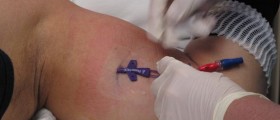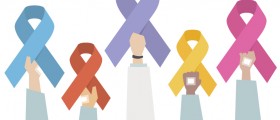Introduction
There are many lymph nodes in our body and they make lymphatic system. When this system suffers from cancer, lymphoma is the name used for this condition. Lymphocytes are the white blood cells, which travel through the lymph vessels and help the immune system.
When a person suffers from lymphoma, these cells begin to rise in number, causing the gathering of these cells and weakening of the immune system. Because of this, patients with lymphoma are easily susceptible to infections. The most common symptom is lymph node swelling in the armpit, neck, or groin.
Pain is very rarely connected with this condition. Two types of lymphoma exist, the first Hodgkin's lymphoma, which is the most common type, and non-Hodgkin's lymphoma, which does not have the Reed-Sternberg cells that can be found in Hodgkin's lymphoma.

Many other types of lymphoma can be found, but they can be divided into two types. The first type is low-grade lymphoma, which grows slowly. The other is high grade, which usually starts suddenly and aggressively.
Non-Hodgkin's lymphoma
This type is very common, and it usually affects older people. The treatment can be positive, but many variables determine the outcome. Do not be fooled by the name, since high-grade lymphoma can be more easily treated than low-grade.
This is mostly because of the symptoms, which are felt when high-grade lymphoma is experienced. But the problem with low-grade is that the symptoms are not evident and detected, so the problem cannot be treated.
Hodgkin's lymphoma
This type of lymphoma has Reed-Sternberg cells and is a very rare type of lymphoma. Unlike the first type of lymphoma we discussed earlier, this type usually targets people between 15 and 35. Though it spreads very rapidly, it is easily treated.
- With current treatment options, HL has a high cure rate. After the advent of successful treatment with radiotherapy (RT) and then subsequently chemotherapy, death rates from HL have declined since 1975, with an additional impressive decrease of 4% per year from 2008 to 2017. Recent data highlight excellent overall survival (OS) of 87% at 5 years across the age span and 95% for pediatric patients.
- The failure rate of first-line therapies has similarly declined with 90% event free survival (EFS) in early stage disease and 80-85% EFS in advanced staged disease. Clinical trials have been essential in contributing to these improvements. With such high survival rates, focus over the last three decades has shifted to reducing both the acute and long-term effects of treatment while maintaining long-term EFS and OS.
- This focus is important as treatment of relapsed/refractory disease requires additional exposure to toxicity through salvage regimens, RT, and potentially high dose therapy with autologous hematopoietic cell transplant (HDT/AHCT).
- Varied multimodal approaches to achieve these goals have been studied in clinical trials, albeit without clear consensus on the best approach. As we move forward with efficacious regimens, we continue to learn how to best incorporate, prioritize, and sequence the use of newer agents. This can be enhanced, in part, by incorporating patient-reported outcomes (PROs). This is an exciting step toward understanding the patient-level impact of regimens on EFS, OS, and tolerability of acute and long-term effects of treatment.
Complication
First possible complication is an immunocompromised state. Because of the body's condition, a weak immune system makes the body susceptible to infections. Problems like tiredness, fever, aching muscles, headache, and diarrhea are experienced.
If the chemotherapy has been aggressive, problems with damaged stem cells may arise. When bone marrow is seriously damaged, healthy stem cells will have to be extracted from the blood. New bone marrow will have to be produced after the treatment.
Because of this, stem cells are collected and kept, to be used after the treatment. They will help with bone marrow production.
The last complication possible is infertility, which can occur after a high dose of chemotherapy or radiation. Men can keep the sperm before the treatment to avoid this problem.

















Your thoughts on this
Loading...